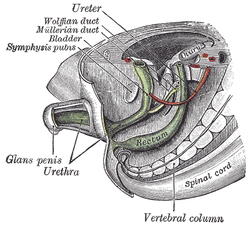- Paramesonephric duct
-
Paramesonephric duct Urogenital sinus of female human embryo of eight and a half to nine weeks old. Tail end of human embryo, from eight and a half to nine weeks old. Latin ductus paramesonephricus Gray's subject #252 1206 Carnegie stage 17 Precursor Intermediate mesoderm Code TE E5.7.2.3.0.0.3 MeSH Mullerian+Ducts Müllerian ducts (or paramesonephric ducts) are paired ducts of the embryo that run down the lateral sides of the urogenital ridge and terminate at the Müllerian eminence in the primitive urogenital sinus. In the female, they will develop to form the Fallopian tubes, uterus, cervix, and the upper two-third of the vagina;[1] in the male, they are lost. These ducts are made of tissue of mesodermal origin.[2]
Contents
Development
The female reproductive system is composed of two embryological segments: the urogenital sinus and the Müllerian ducts. The two are conjoined at the Müllerian tubercle.[3] Müllerian ducts are present on the embryo of both sexes.[4] Only in females do they develop into reproductive organs. They degenerate in males, but the adjoining Wolffian ducts develop into male reproductive organs. The sex based differences in the contributions of the Müllerian ducts to reproductive organs is based on the presence, and degree of presence, of Müllerian Inhibiting factor.
Regulation of development
The development of the Müllerian ducts is controlled by the presence or absence of "AMH", or Anti-Müllerian hormone (also known as "MIF" for "Müllerian-inhibiting factor", or "MIH" for "Müllerian-inhibiting hormone").[5]
Male embryogenesis The testes produce AMH and as a result the development of the Müllerian ducts is inhibited. Disturbances can lead to persistent Müllerian duct syndrome. The ducts disappear except for the vestigial vagina masculina and the appendix testis. Female embryogenesis The absence of AMH results in the development of female reproductive organs, as noted above. Disturbance in the development may result in uterine absence (Müllerian agenesis) or uterine malformations. The ducts develop into the upper vagina, cervix, uterus and oviducts. Eponym
They are named after Johannes Peter Müller, a physiologist who described these ducts in his text "Bildungsgeschichte der Genitalien" in 1830.
Additional images
See also
- Defeminization
- prostatic utricle
- List of homologues of the human reproductive system
- Sexual differentiation
References
- ^ Sizonenko, P.C.. "Human Sexual Differentiation". http://www.gfmer.ch/Books/Reproductive_health/Human_sexual_differentiation.html. Retrieved 2008-09-04.
- ^ Hashimoto R (2011-07-27). "Development of the human Müllerian duct in the sexually undifferentiated stage". The Anatomical Record Part A: Discoveries in Molecular, Cellular, and Evolutionary Biology 272 (2): 514–9. doi:10.1002/ar.a.10061. PMID 12740945.
- ^ Yasmin Sajjad (2011-07-27). "Development of the genital ducts and external genitalia in the early human embryo". The Journal of Obstetrics and Gynaecology Research 36 (5): 929–937. doi:10.1111/j.1447-0756.2010.01272.x.
- ^ Rey R, Grinspon R (2011-07-27). "Normal male sexual differentiation and aetiology of disorders of sex development". Male Reproductive Endocrinology 25 (2): 221–238. doi:10.1016/j.beem.2010.08.013.
- ^ Ball B, Conley A, Grundy S, Sabeur K, Liu I (2011-07-27). "Expression of anti-Mullerian hormone (AMH) in the equine testis". Theriogenology 69 (5): 624–631.
External links
- genital-010 — Embryology at UNC
- How the Body Works / Sex Development / Sexual Differentiation / Duct Differentiation - The Hospital for Sick Children (GTA - Toronto, Ontario, Canada)
Prenatal development/mammalian embryogenesis · Development of the urinary and reproductive organs (GA 11.1204, TE E5.6-7) Common urinary and
reproductive systemUrinary system
developmentNephrotome → Pronephros · Mesonephros (Mesonephric tubules)
WD → Ureteric bud + Metanephrogenic blastema
US → Urinary bladder + Urethra + Primary urethral groove + UrachusReproductive system
developmentPrimarily internalGonadal ridge → Indifferent gonad → Gonadal cord (Cortical cords, Testis cords)
Pronephric duct/Wolffian duct/mesonephric duct + Müllerian duct/paramesonephric ducts (Vaginal plate)
US → Prostate or Skene's glandPrimarily externalLPM → Genital tubercle → Labioscrotal swelling → Scrotum or Labia majora
LPM → Genital tubercle → Primordial phallus → Penis or Clitoris
Peritoneum → Processus vaginalis or Canal of NuckHomologues Categories:- Embryology of urogenital system
Wikimedia Foundation. 2010.





